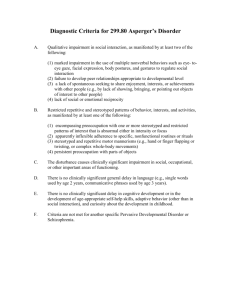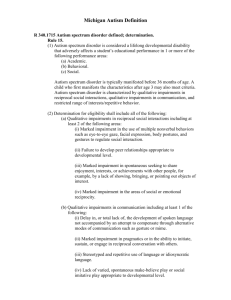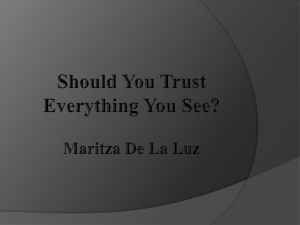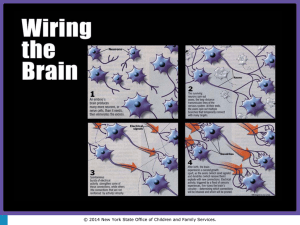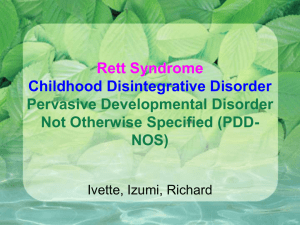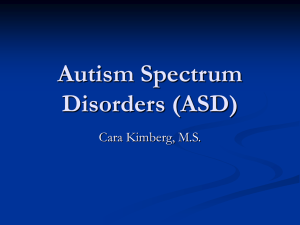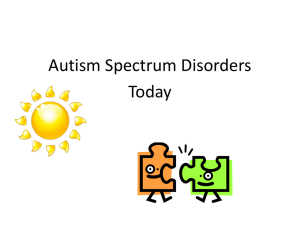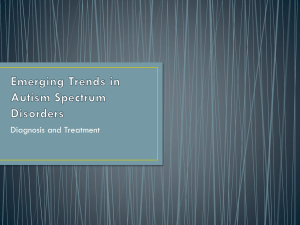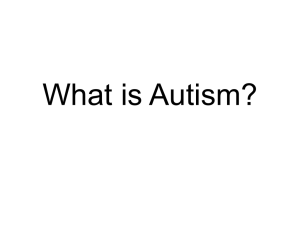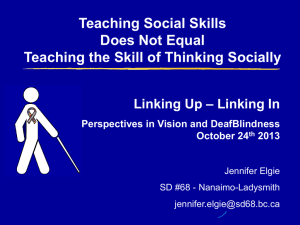Appendix 4: Diagnostic criteria for ASD (DSM-IV
advertisement
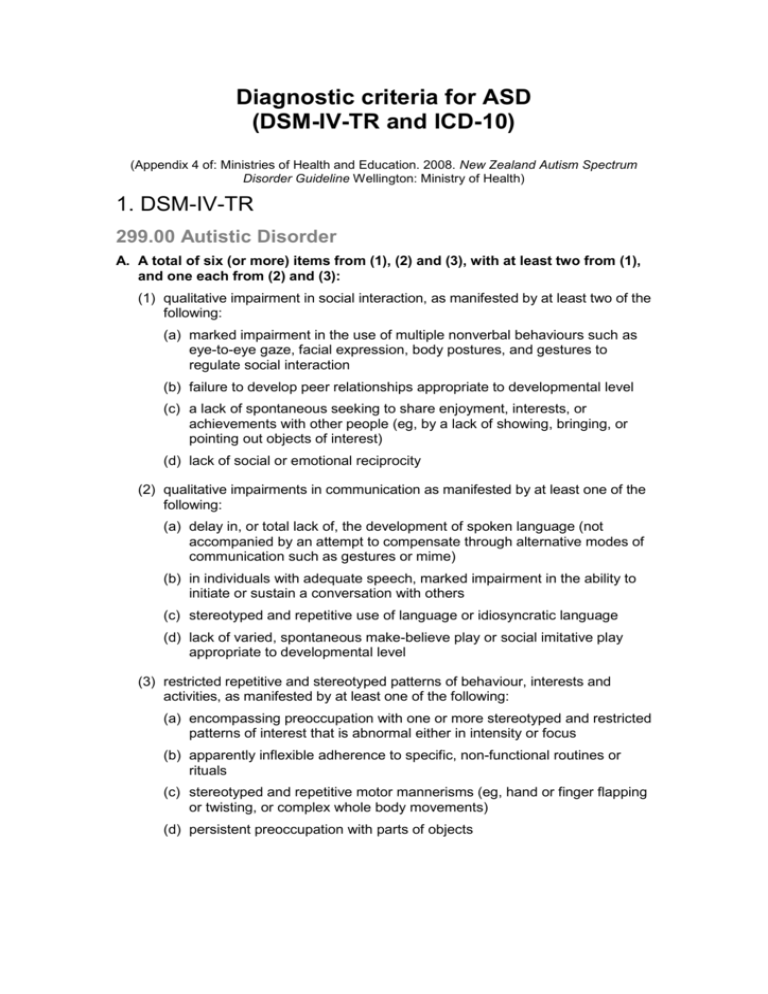
Diagnostic criteria for ASD (DSM-IV-TR and ICD-10) (Appendix 4 of: Ministries of Health and Education. 2008. New Zealand Autism Spectrum Disorder Guideline Wellington: Ministry of Health) 1. DSM-IV-TR 299.00 Autistic Disorder A. A total of six (or more) items from (1), (2) and (3), with at least two from (1), and one each from (2) and (3): (1) qualitative impairment in social interaction, as manifested by at least two of the following: (a) marked impairment in the use of multiple nonverbal behaviours such as eye-to-eye gaze, facial expression, body postures, and gestures to regulate social interaction (b) failure to develop peer relationships appropriate to developmental level (c) a lack of spontaneous seeking to share enjoyment, interests, or achievements with other people (eg, by a lack of showing, bringing, or pointing out objects of interest) (d) lack of social or emotional reciprocity (2) qualitative impairments in communication as manifested by at least one of the following: (a) delay in, or total lack of, the development of spoken language (not accompanied by an attempt to compensate through alternative modes of communication such as gestures or mime) (b) in individuals with adequate speech, marked impairment in the ability to initiate or sustain a conversation with others (c) stereotyped and repetitive use of language or idiosyncratic language (d) lack of varied, spontaneous make-believe play or social imitative play appropriate to developmental level (3) restricted repetitive and stereotyped patterns of behaviour, interests and activities, as manifested by at least one of the following: (a) encompassing preoccupation with one or more stereotyped and restricted patterns of interest that is abnormal either in intensity or focus (b) apparently inflexible adherence to specific, non-functional routines or rituals (c) stereotyped and repetitive motor mannerisms (eg, hand or finger flapping or twisting, or complex whole body movements) (d) persistent preoccupation with parts of objects B. Delays or abnormal functioning in at least one of the following areas, with onset prior to age 3 years: (1) social interaction, (2) language as used in social communication or (3) symbolic or imaginative play C. The disturbance is not better accounted for by Rett’s Disorder or Childhood Disintegrative Disorder 299.80 Asperger’s Disorder A. Qualitative impairment in social interaction, as manifested by at least two of the following: (1) marked impairment in the use of multiple nonverbal behaviours such as eyeto-eye gaze, facial expression, body postures, and gestures to regulate social interaction (2) failure to develop peer relationships appropriate to developmental level (3) a lack of spontaneous seeking to share enjoyment, interests, or achievements with other people (eg, by a lack of showing, bringing or pointing out objects of interest to other people) (4) lack of social or emotional reciprocity B. Restricted repetitive and stereotyped patterns of behaviour, interests, and activities, as manifested by at least one of the following: (1) encompassing preoccupation with one or more stereotyped and restricted patterns of interest that is abnormal either in intensity or focus (2) apparently inflexible adherence to specific, non functional routines or rituals (3) stereotyped and repetitive motor mannerisms (eg, hand or finger flapping or twisting, or complex whole-body movements) (4) persistent preoccupation with parts of objects C. The disturbance causes clinically significant impairment in social, occupational, or other important areas of functioning. D. There is no clinically significant general delay in language (eg, single words used by age 2 years, communicative phrases used by age 3 years). E. There is no clinically significant delay in cognitive development or in the development of age-appropriate self-help skills, adaptive behaviour (other than in social interaction), and curiosity about the environment in childhood. F. Criteria are not met for another specific Pervasive Developmental Disorder or Schizophrenia. 299.80 Pervasive Developmental Disorder Not Otherwise Specified (Including Atypical Autism) This category should be used when there is a severe and pervasive impairment in the development of reciprocal social interaction associated with impairment in either verbal or nonverbal communication skills or with the presence of stereotyped behaviour, interest, and activities, but the criteria are not met for a specific Pervasive Developmental Disorder, Schizophrenia, Schizotypal Personality Disorder, or Avoidant Personality Disorder. For example, this category includes ‘atypical autism’ – presentations that do not meet the criteria for Autistic Disorder because of late age at onset, atypical symptomatology, or subthreshold symptomatology, or all of these. The diagnostic criteria for DSM-IV-TR have been reprinted with permission from the Diagnostic and Statistical Manual of Mental Disorders, Fourth Edition, Text Revision, (Copyright 2000). American Psychiatric Association. 2. ICD-10 F84 Pervasive developmental disorders A group of disorders characterized by qualitative abnormalities in reciprocal social interactions and in patterns of communication, and by a restricted, stereotyped, repetitive repertoire of interests and activities. These qualitative abnormalities are a pervasive feature of the individual’s functioning in all situations. Use additional code, if desired, to identify any associated medical condition and mental retardation. F84.0 Childhood autism A type of pervasive developmental disorder that is defined by: (a) the presence of abnormal or impaired development that is manifest before the age of three years, and (b) the characteristic type of abnormal functioning in all the three areas of psychopathology: reciprocal social interaction, communication, and restricted, stereotyped, repetitive behaviour. In addition to these specific diagnostic features, a range of other nonspecific problems are common, such as phobias, sleeping and eating disturbances, temper tantrums, and (self-directed) aggression. Autistic disorder Infantile: • autism • psychosis Kanner’s syndrome Excludes: autistic psychopathy (F84.5) F84.1 Atypical autism A type of pervasive developmental disorder that differs from childhood autism either in age of onset or in failing to fulfil all three sets of diagnostic criteria. This subcategory should be used when there is abnormal and impaired development that is present only after age three years, and a lack of sufficient demonstrable abnormalities in one or two of the three areas of psychopathology required for the diagnosis of autism (namely, reciprocal social interactions, communication, and restricted, stereotyped, repetitive behaviour) in spite of characteristic abnormalities in the other area(s). Atypical autism arises most often in profoundly retarded individuals and in individuals with a severe specific developmental disorder of receptive language. Atypical childhood psychosis Mental retardation with autistic features Use additional code (F70-F79), if desired, to identify mental retardation. F84.5 Asperger’s syndrome A disorder of uncertain nosological validity, characterized by the same type of qualitative abnormalities of reciprocal social interaction that typify autism, together with a restricted, stereotyped, repetitive repertoire of interests and activities. It differs from autism primarily in the fact that there is no general delay or retardation in language or in cognitive development. This disorder is often associated with marked clumsiness. There is a strong tendency for the abnormalities to persist into adolescence and adult life. Psychotic episodes occasionally occur in early adult life. Autistic psychopathy Schizoid disorder of childhood F84.8 Other pervasive developmental disorders F84.9 Pervasive developmental disorder, unspecified The diagnostic criteria for ICD-10 have been reprinted with permission from the World Health Organization.
